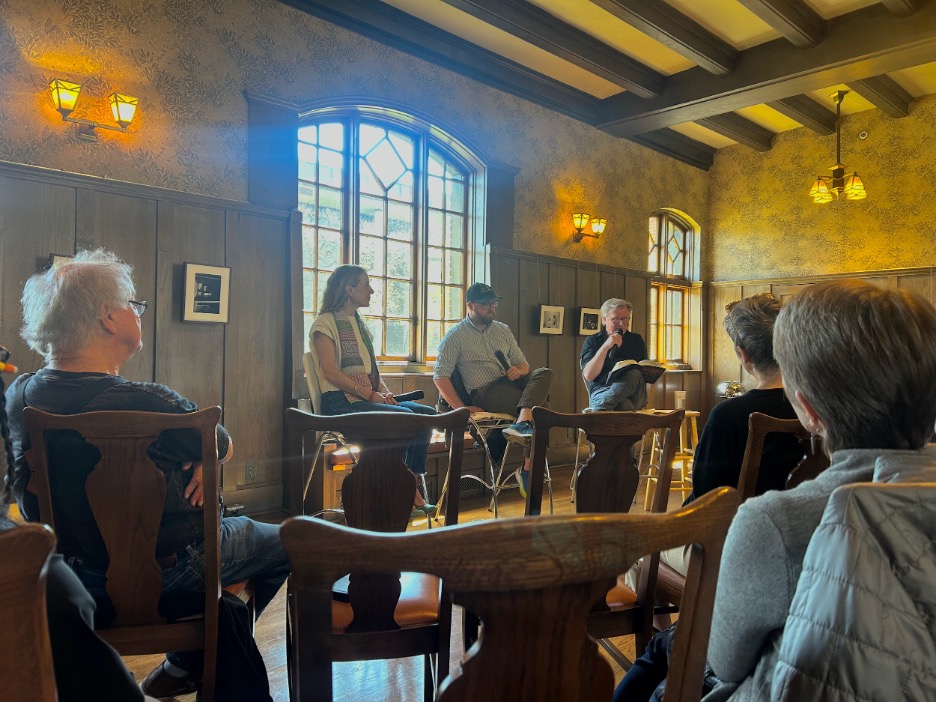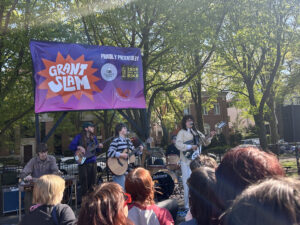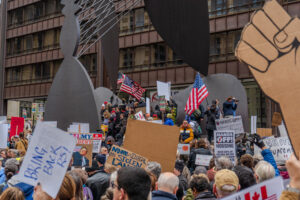“What is the right response to the kind of fascist regime that we seem to be living under? What can we do?” asked Liesl Olson, director of the Jane Addams Hull-House Museum.
“Act Well Your Part, There All The Honor Lies,” a quote from Alexander Pope and the title of the ongoing exhibit and festival happening at the Hull-House, offers an answer to her question. The exhibit explores the theater’s history from its first construction in 1889, through Robert Sickinger’s iconic tenure as theater director from 1963 to 1969, known for creating “Off-Loop,” and now as the world faces uncertainty and political turmoil.
“There’s a kind of directive to just do what you do best, right? Play your role. What do you do really well that can connect you to your community?” Olson said.
“Hull-House Theatre in the 1960s: A Conversation with Mark Larson, Matthew Randle-Bent and Liesl Olson” was one of several events within the “Act Well Your Part” program. The panelists provided ample historical context, but the larger focus was around theater in the 1960s and Sickinger’s impact not only on Hull-House Theatre, but on Chicago theater in general.
“With this exhibition, programming and publication, one of the links that we’re really aiming to make is the energy around Hull-House when Sickinger arrives, with the energy that was at work here at Hull-House, really starting in the 1890s,” Olson said.
According to Olson, from its beginning, Hull-House was always a space for young people in the community to thrive. The settlement, which provided housing and resources for immigrants, also offered social services ranging from arts and manual training to language and citizenship classes.
“It provided social services, but also was just a kind of community gathering space where neighbors could access space for whatever it is that they need, whether that’s a bingo club or building trade union banners ahead of a march,” Randle-Bent said.
Hull-House’s theatrical mission transformed when Sickinger came into the picture, but its foundation was always rooted in community service.
“Sickinger, I mean, he drank up Jane Addams,” Olson said. “He really read deeply about community-based theater, casting people from the neighborhood, coaxing notable performances out of amateur actors and theater as a kind of fabric of a community.”
Sickinger was experimental and ambitious, adapting productions like Harold Pinter’s “The Dumb Waiter,” which, according to Larson, was not being done anywhere else in Chicago at that time.
“Unless you were somebody who could afford to go to New York and see some off-Broadway, you probably were seeing this for the first time,” he said. “At that time, you don’t have summer stock and community theaters going ‘Let’s do “Waiting For Godot.”’ It just wasn’t happening.”
At first, Sickinger’s productions took place in people’s homes as he began to create a donor base and following. Larson also noted that Sickinger wasn’t necessarily paying proper rights to the plays that he adapted.
“He was doing stuff that was happening off Broadway and never asked anybody. He just was doing it,” Larson said.
Part of that creative liberty came from the absence of any voice of established criticism in Chicago theater at the time, according to Olson.
“That also allows artists to do things under the critical radar and get away with it,” she said. “They are allowed this freedom to experiment because there isn’t anyone watching.”
Hull-House Theatre’s political expression was present but not always explicit. A clip from “The Dumb Waiter,” played at the beginning of the panel discussion, featured a slow but menacing scene between its two main characters, Ben and Gus. Instead of sending a straightforward message, the play’s theme remains slightly ambiguous and withheld from the audience, according to Randle-Bent.
“You know that it’s there somewhere, but it’s lurking beneath the surface,” he said. “It requires some effort on behalf of the audience to actually find what it is and interpret it and decide how you feel about that thing.”
Gesturing to framed photos in the back of the room, Randle-Bent pointed out examples of plays that sit on the opposite end of the ambiguity spectrum, such as Bertolt Brecht’s “The Threepenny Opera.”
“It’s not just a critique, it’s a total takedown of capitalist society, corrupt governments, etc.,” he said.
Many of the plays under Sickinger’s direction were framed as “politically avant-garde,” according to Olson. However, she encouraged guests to question what it actually means for the politics of a production to be “avant-garde.”
“Putting on a performance that actually directly tells audience members, ‘This is what you should do’, or ‘This is how you should respond to our political moment,’ or ‘This is how you should organize’ or ‘This is how you should vote,’ whatever it might be. That’s not what the theatre was doing,” she said. “So how do you kind of parse the politics of it? You know, what is the relationship between the politics of the social settlement and the politics of the art that it produces?”
The living legacies of Hull-House Theatre are present not only throughout Chicago, but also in the very audience of this panel discussion. Playwright and actor James Sherman was among the crowd. Sherman was in one of the clips played during the panel, which was Sickinger’s adaptation of “Flora The Red Menace.” Larson made sure to flag Sherman.
“He was only 14 years old when he did that production,” Larson said.
Also in attendance was Francis Guinan of Steppenwolf Theatre Company, representing the generation of Steppenwolf actors from after the company had moved into the Jane Addams space in 1979.
“If you have seen any Chicago theater, you’ve seen Fran, I’m sure,” Larson said.
The physical presence and legacy of Hull-House’s approach to community-based theater persists long after its “prime” in the 1960s.
However, Hull-House’s evolution and role in Chicago’s “Little Theatre Movement” did not happen in isolation. Larson pointed out the impact and significance of the Black Renaissance, spanning from the ‘30s into the ‘50s, as well as Paul Sills’ creation of the Playwright’s Theatre Club at the University of Chicago in 1953. Both were before Sickinger’s time.
“That started what I think of as the Chicago Theatre Movement, where we have a shared vision and are kind of helping each other create this space,” Larson said.
As contemporary artists grapple with political challenges reminiscent of those from previous generations, Hull-House offers a model approach that encourages people to connect with community, take artistic risks and trust that meaningful work will resonate beyond explicit political messaging.
“I think it’s no coincidence that a lot of theaters are actually at this moment turning back to a lot of plays from the 1950s and ’60s,” Randle-Bent said, “because they’re finding new relevance, new meaning in that era.”
The “Act Well Your Part” program will continue Tuesday through Friday from 10 a.m. to 4:50 p.m. and Sunday 12 p.m. to 4:50 p.m. Entry into all of the programs’ events are free to register and are located at the Jane Addams Hull-House Museum at 800 S. Halsted St.










Be First to Comment